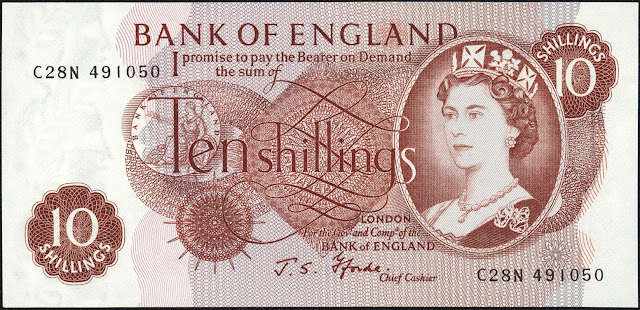Great Britain 10 Shilling Note 1966 Queen Elizabeth II
Bank of England
Obverse: Portrait of Queen Elizabeth II, facing in 1/4 profile to the left. It has the legends “Bank of England” and “I promise to pay the Bearer on Demand the Sum of Ten shillings London For the Gov. and Comp. of the Bank of England”. There are what appear to be Tudor roses in the watermarks, as well as interesting spirograph patterns. The goddess Brittania is shown down and to the left of the queen’s portrait – she is holding out a sheaf of wheat and sitting with a shield at her hip emblazoned with St. George’s Cross.
Signature: John Standish Fforde, Chief Cashier of the Bank of England, between 1966 and 1970.
On the reverse, the seal of the Bank of England (with Britannia again) is much larger and central to the pattern. A rectangle inscribed with “TEN Shillings” overlaps the seal.
Watermark: Repeated images of Britannia with a laurel wreath on her head.
Material: Cotton fiber.
Size: 151 х 71 mm.
Design: Robert Austin.
Date first issued: 12 October 1961.
Date last issued: 13 October 1969.
Date ceased to be legal tender: 22 November 1970.
Printer: Bank of England print works, Loughton (Debden), Essex, United Kingdom.
Portrait of Queen Elizabeth II
This is the first portrait of a monarch to appear on a banknote issued by the Bank of England. It was drawn by Robert Austin, who was responsible for designing the 10-shilling and 1-pound notes of the ‘C’ series of notes issued by the Bank of England. Austin commenced his portrait by obtaining photographs of Her Majesty at a session in Buckingham Palace on 1 May 1956. The photographs were taken by a senior assistant of Dorothy Wilding. However, the final drawing by Austin was not based on a specific photograph from this session, it was a composite of a number of sources. The vignette on the notes shows Her Majesty wearing the George IV State Diadem, Queen Victoria’s Collet Necklace, Queen Mary’s Floret Earrings, and Queen Mary’s Dorset Bow Brooch. The necklace, which was left to the Crown by Queen Victoria in 1901, contains diamonds taken from a Garter badge and a ceremonial sword. The pear-shaped stone on the necklace is known as the Lahore Diamond. The Dorset Bow Brooch was made by Carrington and Company and presented as a wedding gift to Queen Mary in 1893 by the ‘County of Dorset’. Queen Mary gave the brooch to Princess Elizabeth as a wedding present in 1947. The engraving of Austin’s portrait was executed by R. Godbehear of Bradbury Wilkinson and Company. There was widespread criticism of the portrait when the notes were issued.
BANK OF ENGLAND NOTES PORTRAIT SERIES C
Bank of England 10 Shilling Note 1949 Britannia
Bank of England 10 Shilling Note 1966 Queen Elizabeth II
Bank of England 10 Shilling Note 1966 Queen Elizabeth II

